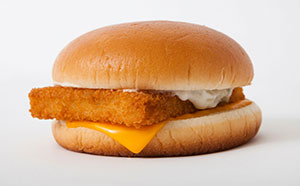Douglas Coupland: Fish wish

Simply sign up to the Life & Arts myFT Digest -- delivered directly to your inbox.
At a friend’s art opening in Reykjavik two years back, everyone was asking the usual, “So where’s everyone going after this?” From what I could tell, everyone was going to a place called “Veesh-nyu-fair-heer” or “Fees-y’iu-vare-hir”. It’s Icelandic, the one language on earth where it sounds like they’re just making up the words as they go along. I didn’t even try to get the name right but, after we walked through the city’s quiet lanes of colourful houses, we ended up at a restaurant named Fish You Were Here. I was charmed.
***
A few years back I was doing a cross-Canada speaking tour with a very tight schedule. Between planes, trains and automobiles and the actual venues themselves, my body did this thing it always does when I’m around too many people and when I’m underslept: my appetite turned off – a reflex that perhaps conveys a Darwinian advantage during battles. Regardless, I could barely drink water and after three days it began impacting my energy and concentration. A friend who was in charge of getting me from A to B to C said there had to be something, anything, out there that I could eat. Baby food? Milk? Chocolate bars? The only thing I could think of was a room temperature McDonald’s Filet-O-Fish sandwich. So we got into a cab and found a local McDonald’s and I ordered two of them and sat at the table and stared at them while they cooled down. If nothing else, I thought to myself, “Uh oh . . . this is what it must feel like to be 95 years old.” Then I unwrapped one of the sandwiches and took three mouthfuls, which was when I realised that Filet-O-Fish sandwiches are best eaten while still hot, as this is how they are scientifically engineered to be ingested. Once they cool down, they lose their, um, photographability. That evening I remembered 2 per cent cottage cheese and got some from a local grocery, and starvation was kept at bay.
***
The Filet-O-Fish is a fish sandwich invented in Ohio in 1962 and now sold globally by McDonald’s. Other chains have their own variant. A McDonald’s fish sandwich contains a fried fish fillet patty commonly consisting of pollock, tartare sauce and processed American cheese inside a steamed bun. It was developed as a response to Catholic neighbourhoods not eating meat on Fridays, and its then competition in the McDonald’s universe was the Hula Burger invented by Ray Kroc — a grilled pineapple ring with cheese in a bun (OMG for real?), which was quickly discontinued.
***

We never think about what a fish fillet is, if we think of them at all. It’s a white breaded rectangle containing . . . fish. Not salmon. Not trout. Not cod. It’s more like an abstract white gummable flakiness guaranteed to not have bones. Poor little fish who gave up its life to make a fishwich. It’s always struck me as odd that people care so much about what kind of meat they’re eating but when it comes to Filet-O-Fish it’s more like, “I’m not-asking-don’t-tell-me. White, flaky, boneless and hot is all I care about.” I mean, you’d always want to know the difference between beef, pork, lamb and chicken on a menu but . . . well, you get my point.
Pollock?
I think that part of most people’s not knowing or caring what’s inside the breadcrumbs and batter is that they might be getting bad news in the form of: well, we used to use Fish A, but it almost went extinct, so we switched to Fish B, but then it collapsed so now we’re using a bit of Fish C mixed in with bits of Fish D when we can get it. An absence of curiosity about what’s inside the batter is also strange given how determined so many fast-food restaurants have recently become in trying to prove that customers are getting real beef and not pink slime in their burgers. Supply chain transparency is the new black.
. . .
For the record, pink slime is, to be polite, beef “trimmings” exposed to heat and centripetal force to remove fat. Ammonia or citric acid is added to the remains to kill bacteria and, voilà! . . . pink slime, also called “Lean Finely Textured Beef”. I wonder what sort of shock waves have rippled through the pink slime community as public awareness of its existence has emerged over the past decade? That’s kind of funny, trying to imagine what the pink slime community might actually look like . . . a round table populated by school lunch marms, prison canteen menu planners and senior assisted living centre directors — and agricultural industry lobbyists: lots and lots and lots of lobbyists.
. . .
Cod fish is one of the first reasons Europeans began visiting North America. In 1992, after decades of extreme industrialised overfishing, northern cod biomass sank to 1 per cent of its historical level and the Canadian government declared a moratorium on fishing it, thus shattering a way of life that went back five centuries. But what else was there to do but save the tiny number of fish that managed to survive? Extinction is extinction. Even politicians couldn’t maintain the lie of permanent abundance. In parables and allegories, fish represent the soul. The way we think about fish tells us about how we see our souls. The fish fillet sandwich seems to encapsulate much that’s wrong with our current thinking. Our oceans deserve love, and our food needs to be more real. And I really like tartare sauce, and I don’t think I say that out loud often enough.
Douglas Coupland is currently artist in residence at the Google Cultural Institute in Paris. He also has a museum show at Rotterdam’s Witte de With Center for Contemporary Art. Twitter @DougCoupland
Photograph: Alamy
Comments